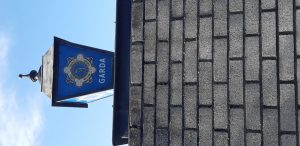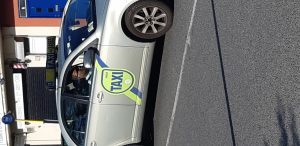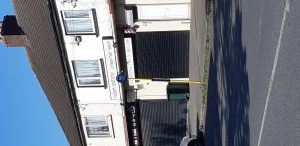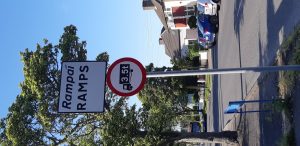Craig McHugh
Prof Bledsoe
LING343
28th June 2019
The linguistic landscape of Dublin is fascinating, especially to a history major like myself. Although everyone I have encountered here has spoken English, all government-planned signs and services are in Irish as well as English. An example of a state service which is referred to entirely by its Irish name is the Garda, or Police. The pictures I have taken from the neighbourhood Santry where I am living helps illustrate these points.
The first image shows a sign for a ramp on the road, or rampai. As I have said, not a single person I have met here speaks only Irish, which would suggest that rather than provide access for the speakers of this minority language, the government is actually trying to promote its usage. These are the two reasons Leeman and Modan give for the existence of such bi-lingual signs (358), but I believe that this is rather simplistic. As well as promote Irish, I believe these signs also serve to protect the nation’s ancient culture, and are undoubtedly connected to the country’s colonial history with the British. Such bi-lingual government initiatives have caught on in Wales and even Scotland for the same reason (using Welsh and Gaelic respectively on signs in these countries as well as English to protect their pre-colonial history). This is a clear example of “historical forces shaping the environment” (Leeman and Modan, 336).
The Garda, or Police, are an example of a state service which only uses their Irish name. In my internship I am dealing with historical newspaper articles regarding police corruption in Ireland, and in these articles the force here are always referred to as the Garda.Despite the overall population speaking English, they almost all refer to the police by their Irish name too. There could well be a historical reasoning behind such usage of the term Garda which I would presume goes even further back than British colonialism. However, despite this fact, the decision to keep the Irish name alive has in a way led to a promotion of the ancient language, and this is clear in English speakers’ usage of the term. Attached are images from the outside of the Garda station in Santry (which in hindsight I must looked rather suspicious obtaining).
Despite the Irish language being plastered all over the old city, it is undeniable that the English language rules the roost in Dublin. Even with the existence of a longstanding historical tension between the Irish and the British, English has still prevailed here. The usage of English is by far the most obvious indication of Ireland’s colonial past. Even the most infamous anti-British terrorist group, the Irish Republican Army (or IRA), uses the language of their “oppressors” in their name (which is admittedly ironic, to say the least). Due to the controversial nature of the IRA, however, I decided to go in a safer direction when it came to obtaining images that displayed the widespread usage of English in Dublin. Of the pictures I did obtain, one of the pictures shows that there is no Irish equivalent of the term taxi, and another displays the fact that the overwhelming majority of private businesses here in Dublin use English. There is a clear distinction between state-usage of language in the city and private usage of language. This supports the claim of both Leeman and Modan that “the elements of LL (linguistic landscape)… (are) artefacts of state driven processes” but are also ~produced by individuals or private establishments” (334).
This doesn’t mean that all businesses use English in Dublin though. In fact, many businesses employ the usage of Irish to enhance their profitability. This is mostly the case with tourist-linked businesses, such as the Guinness Storehouse, which offers a tour of one of the factories in the city centre which has a built-in museum. Before consuming each (free) pint of Guinness here, you are expected to yell Slainte, which is Irish for “cheers”. This is obviously to enchant visiting tourists, whilst giving them more than just a taste for the stout but a taste of the culture in general. As the authors from this week’s readings state, “Consumption becomes culture, and culture becomes consumption” (Leeman and Modan, 337). In many tourist-trap businesses, the Irish language is being commodified in order to enchant its customers, who presumably come from all over the world and are maybe seeing the Irish language for the first time. Ireland is already attached in many people’s minds to ancient mystique, and commodifying the language cleverly taps into this stereotype.
To conclude, Dublin is a city in which an overwhelming majority of the population speak English as their first and even their only, language. However, the Irish language refuses to go away, and can be seen all over the city, be it on the ever-present vehicles of the Garda or in the tourist hot-spots in the centre of town. These two languages are the most prominent in Dublin’s linguistic landscape, but this is not to say that the city is not multi-cultural: it is. In reality, many different nationalities coincide in this now-global city. 


 9
9
Hi Craig! Great essay! Where would you say most of the tourists in Dublin are from? Do you ever hear foreign languages being spoken on the street?
Hey Craigery! I think your analysis on the use of the Irish Gaelic is insightful. It is amazing how important Irish Gaelic is throughout the city, despite the minimal use of Irish Gaelic in everyday oral conversation. However, I think you may be a bit pessimistic in viewing it as only a tourist scheme. I think you also need to look at the importance of Irish Gaelic in a way of distinguishing the republic of Ireland from northern Ireland and the historical influence of the suppression of Irish Gaelic by the British.
I appreciated the point you ended on that a linguistic landscape is not necessarily representative of the languages and cultures that exist in any given place, Dublin has become a really multi-faceted and multi-cultural place and the fact that Irish remains dominant in the signage has a lot more symbolic purpose than it does practical.